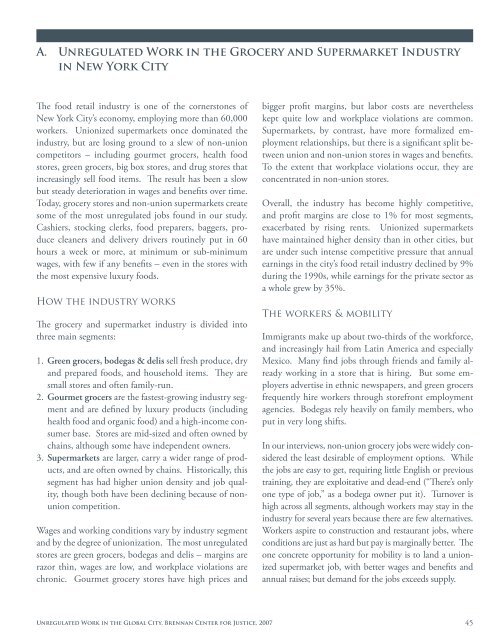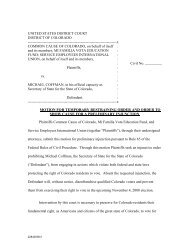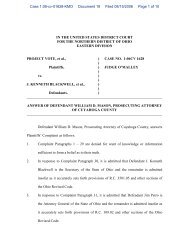A. Unregulated Work in the Grocery and Supermarket Industry in ...
A. Unregulated Work in the Grocery and Supermarket Industry in ...
A. Unregulated Work in the Grocery and Supermarket Industry in ...
Create successful ePaper yourself
Turn your PDF publications into a flip-book with our unique Google optimized e-Paper software.
A. <strong>Unregulated</strong> <strong>Work</strong> <strong>in</strong> <strong>the</strong> <strong>Grocery</strong> <strong>and</strong> <strong>Supermarket</strong> <strong>Industry</strong><strong>in</strong> New York CityThe food retail <strong>in</strong>dustry is one of <strong>the</strong> cornerstones ofNew York City’s economy, employ<strong>in</strong>g more than 60,000workers. Unionized supermarkets once dom<strong>in</strong>ated <strong>the</strong><strong>in</strong>dustry, but are los<strong>in</strong>g ground to a slew of non-unioncompetitors – <strong>in</strong>clud<strong>in</strong>g gourmet grocers, health foodstores, green grocers, big box stores, <strong>and</strong> drug stores that<strong>in</strong>creas<strong>in</strong>gly sell food items. The result has been a slowbut steady deterioration <strong>in</strong> wages <strong>and</strong> benefits over time.Today, grocery stores <strong>and</strong> non-union supermarkets createsome of <strong>the</strong> most unregulated jobs found <strong>in</strong> our study.Cashiers, stock<strong>in</strong>g clerks, food preparers, baggers, producecleaners <strong>and</strong> delivery drivers rout<strong>in</strong>ely put <strong>in</strong> 60hours a week or more, at m<strong>in</strong>imum or sub-m<strong>in</strong>imumwages, with few if any benefits – even <strong>in</strong> <strong>the</strong> stores with<strong>the</strong> most expensive luxury foods.How <strong>the</strong> <strong>in</strong>dustry worksThe grocery <strong>and</strong> supermarket <strong>in</strong>dustry is divided <strong>in</strong>tothree ma<strong>in</strong> segments:1. Green grocers, bodegas & delis sell fresh produce, dry<strong>and</strong> prepared foods, <strong>and</strong> household items. They aresmall stores <strong>and</strong> often family-run.2. Gourmet grocers are <strong>the</strong> fastest-grow<strong>in</strong>g <strong>in</strong>dustry segment<strong>and</strong> are def<strong>in</strong>ed by luxury products (<strong>in</strong>clud<strong>in</strong>ghealth food <strong>and</strong> organic food) <strong>and</strong> a high-<strong>in</strong>come consumerbase. Stores are mid-sized <strong>and</strong> often owned bycha<strong>in</strong>s, although some have <strong>in</strong>dependent owners.3. <strong>Supermarket</strong>s are larger, carry a wider range of products,<strong>and</strong> are often owned by cha<strong>in</strong>s. Historically, thissegment has had higher union density <strong>and</strong> job quality,though both have been decl<strong>in</strong><strong>in</strong>g because of nonunioncompetition.Wages <strong>and</strong> work<strong>in</strong>g conditions vary by <strong>in</strong>dustry segment<strong>and</strong> by <strong>the</strong> degree of unionization. The most unregulatedstores are green grocers, bodegas <strong>and</strong> delis – marg<strong>in</strong>s arerazor th<strong>in</strong>, wages are low, <strong>and</strong> workplace violations arechronic. Gourmet grocery stores have high prices <strong>and</strong>bigger profit marg<strong>in</strong>s, but labor costs are never<strong>the</strong>lesskept quite low <strong>and</strong> workplace violations are common.<strong>Supermarket</strong>s, by contrast, have more formalized employmentrelationships, but <strong>the</strong>re is a significant split betweenunion <strong>and</strong> non-union stores <strong>in</strong> wages <strong>and</strong> benefits.To <strong>the</strong> extent that workplace violations occur, <strong>the</strong>y areconcentrated <strong>in</strong> non-union stores.Overall, <strong>the</strong> <strong>in</strong>dustry has become highly competitive,<strong>and</strong> profit marg<strong>in</strong>s are close to 1% for most segments,exacerbated by ris<strong>in</strong>g rents. Unionized supermarketshave ma<strong>in</strong>ta<strong>in</strong>ed higher density than <strong>in</strong> o<strong>the</strong>r cities, butare under such <strong>in</strong>tense competitive pressure that annualearn<strong>in</strong>gs <strong>in</strong> <strong>the</strong> city’s food retail <strong>in</strong>dustry decl<strong>in</strong>ed by 9%dur<strong>in</strong>g <strong>the</strong> 1990s, while earn<strong>in</strong>gs for <strong>the</strong> private sector asa whole grew by 35%.The workers & mobilityImmigrants make up about two-thirds of <strong>the</strong> workforce,<strong>and</strong> <strong>in</strong>creas<strong>in</strong>gly hail from Lat<strong>in</strong> America <strong>and</strong> especiallyMexico. Many f<strong>in</strong>d jobs through friends <strong>and</strong> family alreadywork<strong>in</strong>g <strong>in</strong> a store that is hir<strong>in</strong>g. But some employersadvertise <strong>in</strong> ethnic newspapers, <strong>and</strong> green grocersfrequently hire workers through storefront employmentagencies. Bodegas rely heavily on family members, whoput <strong>in</strong> very long shifts.In our <strong>in</strong>terviews, non-union grocery jobs were widely considered<strong>the</strong> least desirable of employment options. While<strong>the</strong> jobs are easy to get, requir<strong>in</strong>g little English or previoustra<strong>in</strong><strong>in</strong>g, <strong>the</strong>y are exploitative <strong>and</strong> dead-end (“There’s onlyone type of job,” as a bodega owner put it). Turnover ishigh across all segments, although workers may stay <strong>in</strong> <strong>the</strong><strong>in</strong>dustry for several years because <strong>the</strong>re are few alternatives.<strong>Work</strong>ers aspire to construction <strong>and</strong> restaurant jobs, whereconditions are just as hard but pay is marg<strong>in</strong>ally better. Theone concrete opportunity for mobility is to l<strong>and</strong> a unionizedsupermarket job, with better wages <strong>and</strong> benefits <strong>and</strong>annual raises; but dem<strong>and</strong> for <strong>the</strong> jobs exceeds supply.<strong>Unregulated</strong> <strong>Work</strong> <strong>in</strong> <strong>the</strong> Global City, Brennan Center for Justice, 2007 45
Job quality & workplace violationsAs summarized <strong>in</strong> Table A, workplace violations are common<strong>in</strong> non-union stores. The “go<strong>in</strong>g rate” for many groceryjobs is $250-$300 per week, for 60 or more hours ofwork, easily dropp<strong>in</strong>g hourly wages below <strong>the</strong> m<strong>in</strong>imum.This wage st<strong>and</strong>ard is so widely accepted that employersare conv<strong>in</strong>ced <strong>the</strong>y cannot pay <strong>the</strong> m<strong>in</strong>imum wage <strong>and</strong>still stay <strong>in</strong> bus<strong>in</strong>ess. Some occupations earn even less(food preparers), <strong>and</strong> baggers <strong>and</strong> delivery workers are oftenpaid only <strong>in</strong> tips. <strong>Work</strong>ers are generally paid <strong>in</strong> cash,with poor record keep<strong>in</strong>g. Overtime is almost never paid(<strong>the</strong> same flat weekly rate applies, no matter what <strong>the</strong>hours), <strong>and</strong> breaks are erratic <strong>and</strong> sometimes not givenat all. A recent suit aga<strong>in</strong>st a Brooklyn supermarket isillustrative. N<strong>in</strong>e baggers charged that <strong>the</strong>y were be<strong>in</strong>gpaid only <strong>in</strong> tips, earn<strong>in</strong>g as little as $100 a week for 50-66 hours of work (Confessore 2006).Subcontract<strong>in</strong>g also plays a role <strong>in</strong> driv<strong>in</strong>g down workplacest<strong>and</strong>ards <strong>in</strong> this <strong>in</strong>dustry. Medium-sized stores oftencontract out janitorial <strong>and</strong> delivery jobs, <strong>and</strong> workers<strong>in</strong> <strong>the</strong>se jobs tend to experience <strong>the</strong> worst violations.• Delivery workers (ma<strong>in</strong>ly African immigrant men) areoften hired via <strong>in</strong>formal subcontractors who rout<strong>in</strong>elyviolate employment <strong>and</strong> labor laws. <strong>Work</strong>ers are notgiven meal breaks <strong>and</strong> face arduous work<strong>in</strong>g conditions,especially <strong>in</strong> <strong>the</strong> w<strong>in</strong>ter. They are paid about$75 per week <strong>and</strong> depend on tips, which are unstable<strong>and</strong> vary widely. In <strong>the</strong> words of one deliveryman: “Ifyou are work<strong>in</strong>g <strong>in</strong> an area like Park Avenue, <strong>the</strong>n youdon’t get tips. Sometimes you just see <strong>the</strong> doorman,but even if you see <strong>the</strong> people, <strong>the</strong>y still don’t give youanyth<strong>in</strong>g. It’s rich people, <strong>the</strong>y don’t give it.”• Janitors (ma<strong>in</strong>ly Lat<strong>in</strong>o immigrant men), are oftenhired via <strong>in</strong>formal janitorial contractors to clean smaller,“work<strong>in</strong>g-class” supermarkets overnight, between 8p.m. <strong>and</strong> 8 a.m. The pay is $55 per night; employersdo not keep track of hours, although <strong>the</strong> workers generallyput <strong>in</strong> 60-70 hours per week at different sites.Contractors may pay only a portion of wages due to<strong>the</strong> workers, <strong>and</strong> sometimes do not pay at all.F<strong>in</strong>ally, workers report discrim<strong>in</strong>ation based on complexhierarchies of ethnicity, as well as retaliation for organiz<strong>in</strong>gor compla<strong>in</strong><strong>in</strong>g about work<strong>in</strong>g conditions. Still, <strong>in</strong> responseto an <strong>in</strong>creas<strong>in</strong>g number of wage <strong>and</strong> hour claimsbe<strong>in</strong>g filed aga<strong>in</strong>st green grocers, <strong>the</strong> New York State AttorneyGeneral led an <strong>in</strong>itiative to establish a “GreengrocerCode of Conduct” <strong>in</strong> 2002. In sign<strong>in</strong>g <strong>the</strong> code ofconduct, employers agreed to pay <strong>the</strong> m<strong>in</strong>imum wage <strong>and</strong>follow overtime regulations, <strong>in</strong> exchange for hav<strong>in</strong>g priorviolations dropped (see Section VI for more details).46 <strong>Unregulated</strong> <strong>Work</strong> <strong>in</strong> <strong>the</strong> Global City, Brennan Center for Justice, 2007
Table A.Characteristics of <strong>Unregulated</strong> <strong>Work</strong> <strong>in</strong> <strong>the</strong> <strong>Grocery</strong> & <strong>Supermarket</strong> <strong>Industry</strong><strong>in</strong> New York City<strong>Industry</strong> segments where workplace violations are commonViolations are found <strong>in</strong>:1. Green grocery stores, bodegas <strong>and</strong> delis (violations are prevalent).2. Gourmet grocers/health food stores (violations are frequent).3. Non-union supermarkets (common violations <strong>in</strong> some occupations).Most green groceries, bodegas <strong>and</strong> delis are <strong>in</strong>dependent, immigrant-owned stores with a half dozen em-ployees or less. Gourmet grocery stores are usually part of local cha<strong>in</strong>s, <strong>and</strong> can have 20 or more employees.Non-union supermarkets are typically part of medium <strong>and</strong> even large cha<strong>in</strong>s, with a few publicly traded.No union density <strong>in</strong> green groceries <strong>and</strong> gourmet stores. Union density <strong>in</strong> supermarkets has historicallybeen strong but is decl<strong>in</strong><strong>in</strong>g.<strong>Industry</strong> segmentsOwnership<strong>and</strong> sizeUnion densityThe jobs where workplace violations are commonOccupationsTypical wagesTypical hoursPayment methodBenefitsOccupations most impacted <strong>in</strong>clude cashiers, stock clerks, deli counter workers, food preparers, deliveryworkers, janitors, baggers, produce washers/watchers, <strong>and</strong> flower-arrangers.Green grocery, bodega, <strong>and</strong> deli workers: $250-300 per week is typical. Produce washers <strong>and</strong> foodpreparers earn between $4 <strong>and</strong> $5 per hour.Gourmet grocery workers: Floor workers typically earn between $6 <strong>and</strong> $7 per hour, but canearn up to $9.Non-union supermarket workers: Weekly wages average around $350 a week; baggers earn from$150-$200 (paid <strong>in</strong> tips only). Subcontracted delivery workers earn weekly wages of $75 plus variabletips up to $100, <strong>and</strong> subcontracted janitors earn $55 for a night shift of 12 hours.Hours average 55-75 hours per week <strong>in</strong> green grocery stores; 40-60 hours per week <strong>in</strong> gourmet grocerystores; <strong>and</strong> 40-60 hours per week <strong>in</strong> non-union supermarkets.<strong>Work</strong>ers are largely paid <strong>in</strong> cash at green grocery stores, with <strong>the</strong> exception of occasional cashiers<strong>and</strong> family members of <strong>the</strong> owners. Gourmet grocers <strong>and</strong> supermarkets generally pay on <strong>the</strong> books,though at least a few workers are always paid <strong>in</strong> cash.Health benefits <strong>and</strong> vacation <strong>and</strong> sick days are rare <strong>in</strong> non-union stores.The workers most affected by workplace violationsDemographicsImmigration status<strong>Work</strong>force is almost exclusively immigrant, from Mexico, Central America, Korea, Africa, <strong>the</strong> Caribbean,<strong>and</strong> South Asia. Delivery workers are mostly African immigrants. With <strong>the</strong> exception of cashierjobs, most occupations are male dom<strong>in</strong>ated. Ages range from <strong>the</strong> teens through <strong>the</strong> 40s.Green grocery <strong>and</strong> delivery workers are often undocumented. Some undocumented workers <strong>in</strong> gourmetgrocery stores <strong>and</strong> supermarkets.Intermediaries plac<strong>in</strong>g workers <strong>in</strong> unregulated jobsStorefront employment agencies are frequently used, especially for off-<strong>the</strong>-books jobs, charg<strong>in</strong>g <strong>the</strong> workers $100-$300 perplacement, or $10 for a day job.<strong>Industry</strong>-specific laws <strong>and</strong> regulations<strong>Work</strong>ers are generally covered by all employment rights <strong>and</strong> regulations. In addition, <strong>the</strong> New York State 2007 m<strong>in</strong>imumwage for tipped employees such as delivery drivers is $5.40 or $6.05 an hour (depend<strong>in</strong>g on <strong>the</strong> weekly tip average), but ifa worker’s comb<strong>in</strong>ed wages <strong>and</strong> tips do not at least equal <strong>the</strong> regular state m<strong>in</strong>imum of $7.15 per hour, <strong>the</strong> employer mustmake up <strong>the</strong> difference. In 2002, <strong>the</strong> New York Attorney General established a “Greengrocer Code of Conduct,” <strong>in</strong> whichsignatory grocers agreed to comply with employment <strong>and</strong> labor laws, <strong>and</strong> be monitored for compliance.<strong>Unregulated</strong> <strong>Work</strong> <strong>in</strong> <strong>the</strong> Global City, Brennan Center for Justice, 2007 47
Common workplace violationsM<strong>in</strong>imum wage<strong>and</strong> overtimeNon-paymentof wagesMeal breaksEmployer taxesOSHA<strong>Work</strong>ers’CompensationDiscrim<strong>in</strong>ationRetaliation & <strong>the</strong>right to organizeM<strong>in</strong>imum wage: Violations are pervasive <strong>in</strong> green grocery stores, bodegas <strong>and</strong> delis. <strong>Work</strong>erscommonly put <strong>in</strong> 60-72 hours per week, often result<strong>in</strong>g <strong>in</strong> hourly wages below <strong>the</strong> m<strong>in</strong>imum. Forexample, a worker paid $300 per week for 60 hours will earn $5 per hour (without consider<strong>in</strong>g time<strong>and</strong>-ahalf-pay for overtime hours). The worst jobs can be paid as little as $2.50 an hour. Similarviolations are found <strong>in</strong> gourmet stores, but are somewhat less pervasive. Violations <strong>in</strong> non-unionsupermarkets are concentrated <strong>in</strong> <strong>the</strong> most vulnerable occupations (baggers, delivery workers).Overtime: Green grocery stores rarely pay overtime. Gourmet grocery stores may selectively payovertime (e.g. after six months, or for more skilled workers). Non-union supermarkets often violateovertime laws for baggers <strong>and</strong> delivery workers.Non-payment is rare <strong>in</strong> most occupations, with <strong>the</strong> exception of subcontracted workers (janitors <strong>and</strong>delivery workers).Meal breaks are erratic, <strong>and</strong> green grocery workers <strong>in</strong> particular can work up to 14-hour days without ameal break. Delivery workers typically do not get meal breaks <strong>and</strong> have to eat on <strong>the</strong> job.When employers pay <strong>in</strong> cash, <strong>the</strong>y very rarely pay required taxes.Chemical <strong>and</strong> pesticide exposure is a serious issue for workers h<strong>and</strong>l<strong>in</strong>g sprayed produce, with few safeguardsor tra<strong>in</strong><strong>in</strong>g by employers. Stockers do not receive m<strong>and</strong>ated tra<strong>in</strong><strong>in</strong>g on lift<strong>in</strong>g <strong>and</strong> mov<strong>in</strong>g.Smaller employers do not carry workers’ compensation, <strong>and</strong> across segments, workers rarely receive itwhen <strong>in</strong>jured on <strong>the</strong> job.<strong>Work</strong>ers report hir<strong>in</strong>g, fir<strong>in</strong>g <strong>and</strong> promotion based on immigration status, ethnicity <strong>and</strong> relationshipto owner, as well as harassment based on immigration status.<strong>Work</strong>ers report be<strong>in</strong>g threatened, <strong>in</strong>timidated <strong>and</strong> fired for br<strong>in</strong>g<strong>in</strong>g compla<strong>in</strong>ts or attempt<strong>in</strong>gto organize.Note: All violations were assessed us<strong>in</strong>g legal st<strong>and</strong>ards <strong>in</strong> effect when <strong>in</strong>terviews were conducted, <strong>and</strong> <strong>in</strong> particular, wage rates are from late 2003-early 2005.Sources: Orig<strong>in</strong>al data ga<strong>the</strong>red by authors dur<strong>in</strong>g fieldwork from 2003 through 2006 <strong>in</strong> New York City, as well as <strong>the</strong> follow<strong>in</strong>g secondary sources: Bodie(2003), Bodie (2004), Confessore (2006), Diamond (2004), Greenhouse (2002), Greenhouse (2004d), Greenhouse (2007b), Howell (2003), Janoff (2000),New York Jobs with Justice <strong>and</strong> Queens College Labor Resource Center (2005), New York State Department of Labor (2007b), New York State Departmentof Labor (2007c), Office of <strong>the</strong> New York State Attorney General (2005b), Romano (2006), US Department of Labor (2006f), US Department of Labor(2006g), US Department of Labor (2006h).48 <strong>Unregulated</strong> <strong>Work</strong> <strong>in</strong> <strong>the</strong> Global City, Brennan Center for Justice, 2007




![Download the Letter [PDF] - Brennan Center for Justice](https://img.yumpu.com/50139248/1/190x245/download-the-letter-pdf-brennan-center-for-justice.jpg?quality=85)











